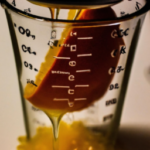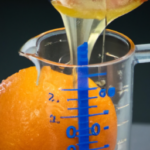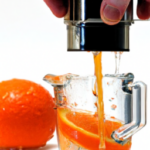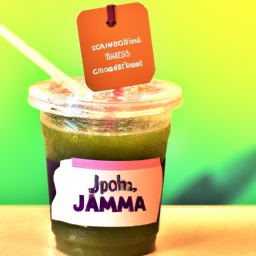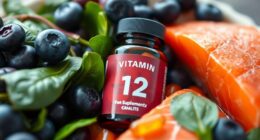- Juicer alternatives
- Best storage
Tips on determining the ripeness of a blood orange for juicing: “Selecting ripe blood oranges, Best practices for storing blood oranges before juicing”
How To Make Blood Orange Juice
Hey there, fellow juice enthusiasts! Today, I want to share with you my tried and tested recipe on how to make delicious homemade blood orange juice.
Blood oranges are a unique and flavorful variety of oranges that are known for their deep red, almost crimson flesh. They are not only visually appealing, but they also have a distinct taste that sets them apart from regular oranges.
To make this refreshing juice, you will need just a few ingredients and some basic kitchen tools. I will guide you through the process step by step, from preparing the blood oranges to adding any optional ingredients to make the juice more interesting.
With this recipe, you can enjoy the goodness of fresh blood oranges any time of the day, whether as a refreshing drink or as a base for cocktails and mocktails.
So, let’s get started and learn how to make this delicious and healthy juice!
Key Takeaways
- Blood oranges are a unique and flavorful variety with deep red flesh that can be used for juicing.
- To prepare blood oranges for juicing, cut off the top and bottom and remove the white pith.
- Blood orange juice pairs well with other citrus fruits, optional ingredients include mint and ginger, and it can be mixed using a spoon, whisk, or blender and strained for pulp-free juice.
- Blood orange juice is a great source of vitamin C, flavonoids, potassium, folate, and vitamin A, and it can be stored in the fridge for up to 3 days or frozen for up to 6 months.
Gather Your Ingredients
You’ll need to gather all of your ingredients before you can start making delicious blood orange juice! First, you’ll need to get some fresh blood oranges. You can usually find them in the produce section of your grocery store or at a local farmer’s market. Make sure they’re ripe and firm to the touch.
Next, you’ll need a juicer. There are several juicing techniques you can use, but I recommend using a citrus juicer. It’s the most efficient way to extract the juice from the oranges. If you don’t have a juicer, you can use a blender or food processor, but you’ll need to strain the juice to remove any pulp.
Additionally, if you don’t have blood oranges, you can use regular oranges or a combination of oranges and grapefruit to make a similar juice.
Now that you have all of your ingredients, it’s time to prepare your blood oranges.
Prepare Your Blood Oranges
After selecting the best ones, aren’t blood oranges easy to peel? The skin is thinner than that of a regular orange and the flesh is reddish-pink, which makes them quite beautiful.
When selecting fresh blood oranges, it’s important to choose ones that are firm and heavy for their size. The best time to buy blood oranges is typically from December to April, when they are in season.
To prepare your blood oranges for juicing, use a sharp knife to cut off the top and bottom of the fruit. Then, stand the orange on one end and cut away the peel and pith in a circular motion, following the curve of the fruit.
Be sure to remove all of the white pith, as it can add a bitter taste to the juice. Once you have peeled all of your blood oranges, you are ready to juice them!
Juice Your Blood Oranges
Now it’s time to start juicing those delicious crimson fruits! There are different juicing techniques you can use depending on the equipment you have. If you have a juicer, cut the blood oranges in half and run them through the machine.
If you don’t have a juicer, you can use a citrus press or squeezer. Cut the oranges in half and place them cut side down on the press. Squeeze the handles together to extract all the juice.
Once you have extracted all of the juice, you can enjoy the blood orange juice as is or you can get creative and pair it with other flavors. Blood orange juice pairs well with other citrus fruits like grapefruit, lemon, and lime. You can also add a hint of sweetness with honey or agave syrup.
In the next section, we’ll talk about how to add any optional ingredients to enhance the flavor of your blood orange juice.
Add Any Optional Ingredients
To elevate the taste of your freshly squeezed blood orange juice, consider incorporating complementary ingredients such as mint leaves or ginger root. Flavor combinations are endless, so experiment with your favorite herbs and spices to create a unique blend of flavors.
Here are some serving suggestions to get you started:
- Add a few sprigs of fresh mint to your blood orange juice for a refreshing and aromatic twist.
- Grate a small piece of ginger root and add it to your juice for a zesty kick.
Another way to add depth to your blood orange juice is to mix it with other juices such as grapefruit or lemon. This will create a more complex flavor profile that will keep you coming back for more.
Now that your juice is ready, let’s move on to the next step of mixing and serving.
Mix and Serve
Let’s get ready to mix and serve this deliciously tangy and sweet concoction, so you can enjoy a refreshing glass of fresh blood orange juice. Once you’ve added any optional ingredients, it’s time to mix your juice.
You can do this using a spoon or a whisk, or you can pour the ingredients into a blender and blend until smooth. If you prefer a pulp-free juice, strain the mixture using a fine-mesh sieve.
Presentation tips can make all the difference when it comes to enjoying your blood orange juice. Serve your juice in a tall glass with ice and a slice of blood orange for garnish. You can also add a sprig of fresh mint or a drizzle of honey for added sweetness.
As for pairing suggestions, blood orange juice goes well with breakfast foods such as pancakes and waffles, or as a refreshing drink with lunch or dinner. Now that you’ve mixed and served your juice, it’s time to store it properly to ensure its freshness and quality.
Store Your Juice
Once you’ve satisfied your thirst with this tangy and sweet beverage, keep it fresh and tasty by storing it in the fridge, like a cool breeze on a hot summer day.
Blood orange juice is best enjoyed fresh, but if you have leftovers, it’s important to preserve its flavor and quality. There are various preservation techniques that you can use to prolong the shelf life of your juice.
One of the simplest ways is to transfer your blood orange juice into an airtight container and place it in the fridge. This will slow down the oxidation process and keep your juice fresh for up to three days.
For longer storage, you can freeze your juice by pouring it into ice cube trays and placing them in the freezer. Once they are frozen, transfer the cubes into a freezer-safe container and store them for up to six months.
Get creative with your storage ideas by putting your juice in mason jars or repurposed glass bottles. Just make sure that they are properly sealed to prevent leaks and contamination.
Now that you know how to store your blood orange juice, it’s time to experiment with different variations.
Experiment with Different Variations
Get ready to spice up your taste buds and try out various twists and tweaks to this zesty and sweet concoction. Experimenting with different flavor combinations is the perfect way to keep things interesting and exciting.
You can add a splash of lime juice for a tangy twist, a dash of cinnamon for a warm and cozy flavor, or even mix in some sparkling water for a refreshing kick.
When it comes to serving suggestions, the possibilities are endless. You can enjoy a tall glass of blood orange juice with breakfast or brunch, pair it with your favorite cocktail for a fun and festive twist, or even use it as a base for a marinade or sauce.
The versatility of this juice is truly remarkable, so don’t be afraid to get creative and try out different variations.
Now, let’s dive into the health benefits of blood orange juice.
Health Benefits of Blood Orange Juice
Exploring the health perks of blood orange juice can be eye-opening, as it’s packed with vitamins and antioxidants. Blood orange juice is a great source of vitamin C, which is essential for a healthy immune system and collagen production.
It also contains flavonoids, which are antioxidants that help protect the body against free radicals and reduce inflammation. Additionally, blood orange juice has potassium, folate, and vitamin A, all of which are vital for overall health.
Moreover, blood orange juice is a versatile drink that can be enjoyed in different ways. Whether you prefer it as a freshly squeezed juice, a smoothie, or a cocktail, it still retains its nutritional value. You can also experiment with different recipe variations to add more flavor and nutrients.
For instance, adding ginger and turmeric to your blood orange juice can boost its anti-inflammatory properties. Overall, drinking blood orange juice is an excellent way to get essential nutrients and enjoy a refreshing drink.
Blood oranges have more uses than just being a refreshing drink. You can use them for making sauces, marinades, and even desserts. Let’s explore some of these other uses for blood oranges.
Other Uses for Blood Oranges
When I think of blood oranges, the first thing that comes to mind is the delicious juice that can be made from them. However, there are also many other uses for these vibrant fruits.
One of my favorite ways to use blood oranges is in cooking and baking, where their unique flavor can add depth to a variety of dishes. They can also be used as beautiful garnishes and decorations, adding a pop of color to any plate.
For those interested in aromatherapy, blood orange essential oil has a variety of health benefits and can be used in diffusers or added to bath products.
Cooking and Baking
You’ll want to roll up your sleeves and get your hands dirty in the kitchen if you’re planning on cooking or baking with blood oranges. These citrus fruits are not only delicious, but they also add a pop of color to any dish. Here are some cooking tips and recipe ideas to help you get started:
First, let’s talk about cooking tips. When using blood oranges in a recipe, it’s important to note that the juice can stain your clothes and countertops. To prevent this, you can wear an apron and place a cutting board underneath your work area. Additionally, blood oranges have a slightly sweeter taste than regular oranges, so you may need to adjust the amount of sugar in your recipe accordingly. Now, onto some recipe ideas:
| Recipe | Ingredients | Directions |
|---|---|---|
| Blood Orange Salad | Blood oranges, arugula, feta cheese, walnuts, balsamic dressing | 1. Peel and slice blood oranges. 2. In a large bowl, combine arugula, feta cheese, and walnuts. 3. Add blood oranges on top. 4. Drizzle balsamic dressing on top. |
| Blood Orange Tart | Pie crust, blood oranges, sugar, eggs, cream cheese | 1. Preheat oven to 375°F. 2. Roll out the pie crust and place it into a tart pan. 3. Slice blood oranges and arrange them on top of the crust. 4. In a separate bowl, mix sugar, eggs, and cream cheese. 5. Pour mixture over the blood oranges. 6. Bake for 35-40 minutes. |
Now that you have some recipe ideas, let’s move onto the next section about garnishes and decorations. Adding a pop of color to your dish can make it more visually appealing and appetizing.
Garnishes and Decorations
To add a finishing touch to your blood orange juice, you can try garnishing it with some creative ideas. For a pop of color, you can add a slice of blood orange or a sprig of mint on the rim of the glass.
You can also sprinkle some finely chopped rosemary or thyme over the top for a burst of flavor. If you’re feeling adventurous, try adding some edible flowers like pansies or violets to your juice.
When choosing garnish ideas, it’s important to consider color combinations that will complement the vibrant hue of the blood orange juice. For instance, you can use green herbs like basil or cilantro to contrast the bright orange color.
Alternatively, you can go for a monochromatic look by using garnishes in the same shade as the juice. No matter what you choose, remember that garnishes can elevate the visual appeal of your drink and make it even more enjoyable to consume.
With that said, let’s move on to the next section about essential oils.
Essential Oils
Essential oils can provide a unique and aromatic twist to your blood orange juice. Not only do they add a burst of flavor, but they also offer therapeutic benefits through aromatherapy blends and diffusing oils. Here are some essential oils and their benefits that you can add to your blood orange juice:
| Essential Oil | Benefits |
|---|---|
| Lemon | Boosts energy and mood, aids digestion |
| Lavender | Calms nerves, promotes relaxation |
| Peppermint | Relieves headaches, aids digestion |
Adding a drop or two of these essential oils to your blood orange juice can enhance the flavor and provide a refreshing and rejuvenating experience. However, it is important to note that essential oils are highly concentrated and should be used in moderation. Always dilute the oils before adding them to your beverage and consult a professional before use.
Incorporating essential oils into your blood orange juice can elevate the taste and provide added health benefits. Experiment with different blends and find the perfect combination for your palate. In the next section, we will discuss some final tips and thoughts on making the perfect blood orange juice.
Final Thoughts and Tips
And now, for some parting words – just remember, the key to a delicious blood orange juice is to always use freshly squeezed juice and to not be afraid to experiment with different flavor combinations!
Here are some final thoughts and tips to keep in mind when making your own blood orange juice:
-
Don’t skimp on the quality of your oranges. Look for oranges that are firm and heavy for their size, with deep red or burgundy skin.
-
Use the right tools to get the most juice out of your oranges. A citrus press or juicer will make the process much easier and more efficient.
-
Try adding other fruits or herbs to your juice for added flavor and nutrition. Some great options include strawberries, mint, or ginger.
-
Serve your blood orange juice in clear glass containers to showcase its vibrant color, and consider pairing it with breakfast foods like pancakes or waffles for a delicious and refreshing start to your day.
With these tips in mind, you’ll be able to make a delicious and refreshing blood orange juice that’s perfect for any occasion. So go ahead and give it a try – your taste buds will thank you!
Frequently Asked Questions
How long does blood orange juice stay fresh for?
Did you know that blood orange juice can stay fresh for up to five days when stored properly? To preserve its freshness, refrigerate the juice in an airtight container and consume it within that time frame.
Can I substitute regular oranges for blood oranges in this recipe?
Yes, you can substitute regular oranges for blood oranges in a juice recipe. However, there are nutritional differences between the two. Blood oranges have more vitamin C, folate, and antioxidants than regular oranges.
Can I use a blender instead of a juicer to make blood orange juice?
Blenders can be used to make blood orange juice, but the result will have more pulp than using a juicer. Consider straining the juice or blending in smaller batches.
What are some common mistakes people make when juicing blood oranges?
When juicing blood oranges, two common mistakes are over squeezing and not removing the white pith. Over squeezing can lead to a bitter taste, while leaving the pith can make the juice too bitter.
How can I tell if a blood orange is ripe and ready to be juiced?
Selecting a ripe blood orange is like finding a diamond in a rough. Look for a smooth, firm skin, heavy feel, and bright color. Store them in a cool, dry place before juicing.
Conclusion
So there you have it, folks! Making blood orange juice is a simple and delicious way to incorporate some extra vitamins and antioxidants into your diet. Plus, it’s a great way to mix up your usual juice routine with a unique and flavorful twist.
Did you know that blood oranges are actually more nutritious than regular oranges? In fact, according to a study by the University of Parma in Italy, blood oranges can contain up to 40% more vitamin C and antioxidants than other oranges.
Just imagine all those powerful nutrients going to work in your body as you sip on a refreshing glass of blood orange juice.
So next time you’re at the grocery store, don’t pass up the opportunity to pick up some blood oranges and give this recipe a try. Your taste buds (and your immune system) will thank you.
Happy juicing!
Ilana has been a vegan for over 10 years. She originally made the switch for health reasons, but soon found herself becoming more and more passionate about the ethical and environmental implications of a vegan lifestyle. Ilana is the author of The Graceful Kitchen, a blog all about veganism. She loves to cook up delicious and nutritious vegan meals, and share her recipes with others who are interested in leading a cruelty-free life. Ilana is also a strong advocate for using whole foods as the foundation of a healthy diet, and believes that going vegan is one of the best ways to achieve this.





